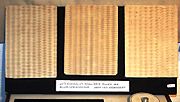
Television Electronic Disc
Encyclopedia


Video
Video is the technology of electronically capturing, recording, processing, storing, transmitting, and reconstructing a sequence of still images representing scenes in motion.- History :...
recording format, released in 1975 by Telefunken
Telefunken
Telefunken is a German radio and television apparatus company, founded in Berlin in 1903, as a joint venture of Siemens & Halske and the Allgemeine Elektricitäts-Gesellschaft...
and Teldec
Teldec
The Teldec is a German record label in Hamburg, Germany. Today the label is a property of Warner Music Group.-History:...
. The format used flexible foil discs, which spun at 1,500 rpm on a cushion of air. TeD never gained wide acceptance, and could not compete against the emerging videocassette
Videocassette recorder
The videocassette recorder , is a type of electro-mechanical device that uses removable videocassettes that contain magnetic tape for recording analog audio and analog video from broadcast television so that the images and sound can be played back at a more convenient time...
systems of the time.
History
Initially known as, "The Video Disc" or the Teldec Television Disc, TeD (Television Electronic Disc) was first announced at a press conference in BerlinBerlin
Berlin is the capital city of Germany and is one of the 16 states of Germany. With a population of 3.45 million people, Berlin is Germany's largest city. It is the second most populous city proper and the seventh most populous urban area in the European Union...
on June 24, 1970. It was developed by a team from two German companies: AEG-Telefunken and Teldec
Teldec
The Teldec is a German record label in Hamburg, Germany. Today the label is a property of Warner Music Group.-History:...
. Program information was stored in the form of ridges in the surface of a thin, flexible foil disc, which was claimed to be sufficiently robust to withstand being played 1,000 times. The main technological breakthrough was the vertical recording method that reduced the track pitch to 0.007 mm, and increased the rotation speed to 1,500 rpm, making it possible to record 130–150 grooves per millimeter, compared with the typical 10–13 grooves on an audio disc. This increased the available bandwidth from around 15 kHz to 3 MHz. The tracks were read by a pressure pick-up, which translated the surface of the ridges, via a piezo-electric crystal, into an electrical signal.
Tracking was controlled not by the pick-up resting within the walls of a groove, but by a mechanical coupling on which the pick-up mounting is supported. There was no turntable. The rotation of the disc at 1,500 rpm created a thin cushion of air between the disc and a fixed plate. Vertical movement of the disc was kept to within 0.05mm. Eight-inch discs could store five minutes of programming, twelve-inch discs about 7½ minutes.
Marketing
By autumn 1972, the name of the system had just been changed to TeD (for Television Disc) and the playing time of the eight-inch disc had been doubled to 10 minutes. TeD players were finally introduced on the West German market on 17 March 1975. Six labels offered programs: DeccaDecca Records
Decca Records began as a British record label established in 1929 by Edward Lewis. Its U.S. label was established in late 1934; however, owing to World War II, the link with the British company was broken for several decades....
, Teldec Intertel
Teldec
The Teldec is a German record label in Hamburg, Germany. Today the label is a property of Warner Music Group.-History:...
, Telefunken
Telefunken
Telefunken is a German radio and television apparatus company, founded in Berlin in 1903, as a joint venture of Siemens & Halske and the Allgemeine Elektricitäts-Gesellschaft...
, Ufa/ATB, Ullstein AV and Videophon. Within the first three months 6,000 players had been shipped to 2,500 dealers, and 50,000 discs were in the shops. Sanyo Electric Co., Ltd.
Sanyo
is a major electronics company and member of the Fortune 500 whose headquarters is located in Moriguchi, Osaka prefecture, Japan. Sanyo targets the middle of the market and has over 230 Subsidiaries and Affiliates....
of Japan
Japan
Japan is an island nation in East Asia. Located in the Pacific Ocean, it lies to the east of the Sea of Japan, China, North Korea, South Korea and Russia, stretching from the Sea of Okhotsk in the north to the East China Sea and Taiwan in the south...
, which had been conducting similar research itself (but was by now also developing the V-Cord
V-Cord
V-Cord was a analog recording videocassette format developed and released by Sanyo in 1974. V-Cord was released in two versions: V-Cord I , which could record a maximum of 60 minutes on one V-Cord cassette, and the later V-Cord II, released in 1976, which could record a maximum of 120 minutes on a...
videocassette recorder), was granted a licence to produce a version that would play out in the NTSC
NTSC
NTSC, named for the National Television System Committee, is the analog television system that is used in most of North America, most of South America , Burma, South Korea, Taiwan, Japan, the Philippines, and some Pacific island nations and territories .Most countries using the NTSC standard, as...
television format and by the end of 1976 had devised a long-awaited auto-changer that took 12 10-minute discs. Also in Japan, General Corporation took a manufacturing licence in July 1976 with an expectation of coming to market in April 1977. A software consortium, Nippon Video Systems, was formed around the same time. By the end of 1978 Telefunken itself had adopted VHS
VHS
The Video Home System is a consumer-level analog recording videocassette standard developed by Victor Company of Japan ....
.

